FAQs About Red Ear Slider Turtle Disease/Health: Traumas
Related Articles:
Treating Common Illnesses of the Red Ear Slider (& other Emydid Turtles) by Darrel Barton,
The Care and Keeping of the Red Eared Slider, Trachemys scripta elegans by Darrel Barton,
Turtle eye diseases; Recognising and treating eye diseases in pet turtles by Neale Monks,
So your turtle has the Flu? Recognising and treating respiratory infections in pet turtles by Neale Monks,
The Care and Keeping of the Red Eared Slider, Trachemys scripta elegans by Darrel Barton,
Red Ear Sliders,
Turtles, Amphibians, Red Eared Slider Care,
Shell Rot in Turtles,
Related FAQs:
RES Disease/Health 1,
RES Disease/Health 2,
RES Disease 3,
RES Health 4,
RES Health 5,
RES Health 6,
RES Health 8,
RES Health 9,
RES Health 10, & Shell Rot, Turtle Disease 1, Turtle Disease 3, Shell Rot, Turtle Respiratory Disease, Turtle Eye Disease,
FAQs on RES Health by Type: Diagnosis, Environmental, Social, Nutritional, Growths/Tumors, Infectious, Parasitic, References,
& Sliders 1,
Sliders 2,
Red Eared Slider Identification,
RES Behavior,
RES Compatibility,
RES Selection,
RES Systems,
RES Feeding,
RES Reproduction,
|
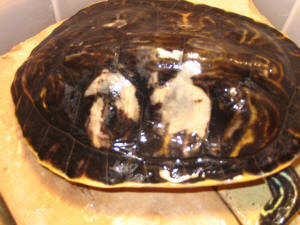
|
Red Eared Slider Turtle
12/16/17
Hi there,
<Hiya, Zack. Darrel here after being away for a while>
I read through what seems like the entirety of your website's turtle content,
and I learned a whole lot! If possible though, I really think myself and my
turtle friend could both benefit from direct communication.
<no problem>
So (rather long story) I recently found a Red Eared Slider turtle on the side of
the interstate that had been hit by a car (presumably).
I know I probably should have left him alone but when I saw that he was alive I
couldn't help but "save" him.
My mother works at a vet clinic and had spoken previously of turtles that had
been hit and brought into the clinic, patched up, and sent to a wildlife rehab
facility. This sounded perfect, however when I brought him into the clinic, they
said the rehab facility was full for now, and that they would have to put him
down unless I wanted to care for him. Obviously I chose the latter option, and
here we are.
Timeline and info:
I found "Okie" Saturday November 18th. He had a crack in his shell (top and
partially bottom) right around his left front leg. The crack begins an inch on
either side of the leg and goes around in a 1/3 circle shape. He was not
moving other than his head, and had bloody puss forming a scab on the crack, but
was no longer bleeding. His eyes were swollen shut.
We immediately got him into the warm car and gave him some water.
Upon arriving home we put him next to a heater to get the temperature to around
75 degrees.
He went to the vet that following Monday and received some sort of reptile
antibiotic and had x rays taken (no internal damage was seen).
All during this time we were working with him on eating, but to no avail,
however he has always been drinking very consistently if put in water.
I brought him back into the vet on the 24th for his second antibiotic shot, at
which time I expressed my concerns about 1) his eyes 2) his lack of appetite and
3) his desire to turn left. The vet fed him with a syringe (maybe 4-6 cc.s of a
green paste) and recommended beta carotene for his eyes (one drop from capsule
in mouth daily). She assumed the left turning was a neuro issue and said to hope
for the best.
Within a day one eye opened partially and by today (Monday) that eye is 75% open
and he has started to move forward instead of just left.
SO, things are looking up, but my two questions are:
1) I read on your site they can go months without eating. Is this true? I'm
really worried about him not eating, but I don't think he will have a desire to
eat until he can see. Also, with him being a wild turtle, how can I get him to
transfer to pelleted food?
2) Just after today's visit to the vet, he started doing this thing where he
opens his mouth and moves his head forward, about once per minute. Your site and
others seem to say this is very bad. What more can I do? He will
get more antibiotic on Friday.
<First, you're getting good care from your vet.>
<Don't worry too much about eating, they can go a long time between meals and
being hit by a car does depress your appetite>
<Water is good for a soaking, but until he has healed and the cracks have
scarred over don't let him SIT in water... keep him warm and dry with daily
bathing. What I'm saying is that when you are sick (you, me or a
turtle) warm, wet conditions are ideal for bacterial and fungal growth right at
a time when we're not equipped to fight it -- so make sure Okie dries out
thoroughly between baths.>
<The constant yawning can be a sign of many things but in reality none of them
are things you can treat so don't worry about that or about the left turning. If
they are all signs of neurological system damage or just from
the actual injury we're not going to know.>
<Keep him warm & dry and during his baths offer him tiny pieces of beef or
chicken liver (TINY pieces) because they are high in basic vitamins that he
needs. Also try earthworms (available at fishing/bait shops) to see if he'll
bite, so to speak. After he begins eating, by all means transition him to Koi
pellets>
<Best of luck to you and Okie>
|
Red Slider; spot on chin 6/11/17
Hi,
<Hiya - Darrel here>
I have a 2 year old red slider and today when I took her out of the tank I
noticed she had a yellowish/brownish spot under her chin. (pic attached)
<Tina's pretty>
It just feels liker her skin when I touched it. I wonder what it is and I don't
know if I should be worried about it.
Any help or guidance would be really appreciated.
<It's hard to tell from here. It looks like it may be a bruise -- just simple
damage from rubbing or scraping against something dull. It's clearly not a
puncture wound or something that broke the skin.>
<I'm going to suggest that you take her out of the water, let her dry off and
then coat it with something like Neosporin or other antibiotic ointment. Let her
stay dry for an hour after that and then put her back in her world>
<Keep an eye on it ... but don't worry about it for now>
Thanks,
Tina the Turtle
|
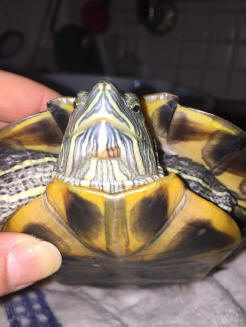 |
|
Re: Red Slider 6/13/17
Dear Darrel,
Thank you so much for your reply. I have done the Polysporin treatment for 3
days and the difference is amazing. The mark is almost all gone !!
Tina and I thanks you very much ❤️��❤️��❤️
|
|
RES Head Wound 12/7/16
Hi there,
<Hiya, Darrel here>
My RES, Bowser, did a face plant outta the basket I had him in when I was
draining his tank today. The fall was less than a foot but his shell skinned
off a layer of his skin right above his eye lids (see pic). It did not bleed
and he doesn't seem to care at all about it. He's not been scratching his
head or anything. I put him back in his tank about a half
hour after it happened and gave him a snack and he ate most of it. I am just
wondering if I should be keeping him dry or if he is okay to be in the
water. I cannot clean the wound as he sucks his head in every time I get
close. Being that the wound is right above his eyelids I cannot put any sort
of topical cream (poly or Neosporin) as I don't want it to get in his
eyes.
Do you have any advice on how I should treat this? Or if it needs to be
treated at all? I am not sure if a vet visit is necessary as the wound
didn't bleed and he doesn't seem bothered or in pain. But if need be I would
take him in right away!
<Bowser should be just fine. They're among the most resilient animals on the
planet. Read here about mechanical injuries, Dry Dock him and treat with
Betadine/Iodine, etc. for a week or so>
<http://www.wetwebmedia.com/FWSubWebIndex/treating%20RES%20Dis%20DarrelB.htm>
|
.JPG)
.JPG) |
|
Re: RES Head Wound 12/29/16
Hi Darrel,
Thanks so much for your reply and advice.
I have taken him out of his tank and put him in a Rubbermaid bin with
towels for packing. Every time he moves around he scrapes it more and
now it is bleeding. I've tried to pack him in so he can't hurt himself
more but I can't be here during the day to make sure he is being still.
Is it advisable to put him back in his tank overnight and during the day
and just
dry dock him for two to three hours a night? I managed to clean the
wounds with Bactine and he let me put polysporin (cream) on it which I
could do every night while he is drying out. I'm afraid if I leave him
alone he will keep skinning his head on his shell and making it worse!
<In this case no. a Wet wound leads to higher chances of infection. You
are doing the right things, trying to pack off the wound, etc. maybe
it's time to go to the next level --can you tie a strip of gauze around
him ...
say over the neck and UNDER the shell ... then tie the ends around the
back of the shell (under the shell lip and above the legs)?
Even if this immobilizes him for a day or so, gives the wound a chance
to start healing, etc.
Melanie Reece
|
Red eared Singaporean turtle is sick. ..need help
5/12/16
Hi
<Hiya – Darrel here>
My name is Farha from India Mumbai. I have 2 red eared turtles for the
last 11 months. They do fine. They were active and normal. Since
yesterday i have noticed that my male turtle is not swimming. Its just
sitting whole day at basking area. He was not eating also. Morning when
i wake up i found him again at the basking area . When i took out from
tank i notices some red marks in his paws. His nails was damaged.
Earlier nails was big. Pls
suggest what should i do...
<He seems to have hurt himself, although some times a female slider will
bite the nails of a male that is bothering her. It’s not a critical
wound as long as he doesn’t get an infection from it. He needs to stay
warm and dry for a while to allow the wounds to heal. Please read this
article – the section on treating wounds.
http://www.wetwebmedia.com/FWSubWebIndex/treating%20RES%20Dis%20DarrelB.htm>
Re: Red eared Singaporean turtle is sick. ..need help
5/23/16
Thank you Darrel
You are right my female turtle only hurt him . I have taken him to
veterinary doc he suggested the same to keep him in dry place .along
with this he found him suffering from congestion in chest and he
suggested two medicine one for wound which is PENDISTRIN SH and for
congestion one liquid which is BETNESOL 15ML (BETAMETHASONE SODIUM
PHOSPHATE ORAL DROPS).
I keep him in dry whole day . Just 10 to 15 min.s for food in water. Pls
suggest if i am doing right.
<You are on the right path, but he should be warm and dry for a few
WEEKS not days. Reptiles heal much more slowly than humans. As he stays
warm and dry his breathing will also improve. Just be sure to give him
that time.>
Red eared slider turtle question. Phys. inj.
5/8/16
Hello,
<Hiya – Darrel here>
I have had a red eared slider for several years now. She has been the
only one we had until about a month ago when a friend no longer wanted
her 2 red eared sliders. I did my research and found that some turtles
of not around other turtles could be aggressive towards each other.
<Yes. Usually as long as the sizes aren’t too different>
So I decided to slowly introduce the new turtles with my older turtle,
before I would put them in the same aquarium. All three of them where
doing great together. I did notice the 2 females had been kind of rough
towards the male turtle which is seriously much smaller than the 2
females.....the oldest name is Frog and her she'll is about 5 inches,
the other female's name is big and her she'll is about 2-3 inches, the
male tiny is maybe an inch to 1 1/2 inches. Today I went to clean out
the aquarium and I pulled all 2 out of the tank....when I looked at tiny
I noticed something different about his foot....his back left leg part
of his foot is gone now..there is skin over that is really pink. When I
first got the 2 new ones the first day I noticed he did have issues
swimming almost as though his foot was broke or injured but it was all
there. I have depressed the male from the females because I am concerned
that one of the females ate it. But is there anything else I should do
at this time for the male Tiny's foot.
<Two issues. First, treat him in isolation. Read:
http://www.wetwebmedia.com/FWSubWebIndex/treating%20RES%20Dis%20DarrelB.htm>
<Second: He’s a baby and shouldn’t be in with adults. He needs his own
place. Don’t work about his foot. After you treat it (see above) he’ll
learn to cope and will do just fine.
http://www.wetwebmedia.com/FWSubWebIndex/RESCareBarton.htm>
|
Red Eared Slider with sores
11/9/15
Hello,
<Hiya – Darrel here>
I recently acquired two turtles at Chinatown in Jakarta because the animals were
kept in very bad conditions and I wanted to offer them a better life.
<Thank you>
One turtle has been developing a kind of lump and I don't know what it is, it
touches hard. I see another yellow spot appearing under the mouth.
<A quick look from the picture suggests those are scars from abrasions, meaning
scrapes or cuts. They can get these from sharp things in the water, sometimes
from bites and scratches and sometimes … strange but true … from their own
shells: I see many water turtles with sores and scars on the top of their heads
from being scraped on a sharp spot on their own shell.>
She likes to spend most of the day inside a hollow log covered in water, while
her friend rests on top of the log. So I don't know if she got hurt inside. The
water is cleaned at the latest every third day. We take them out to walk on the
grass as well.
She's eating well (turtle pellets) and her behaviour is normal. As your page
suggests I've already put her in a dry place.
There 're no turtle vets here nor turtle clubs. Even for human beings medical
care is very poor.
What can I do?
<This page describes the dry docking as you are doing.
http://www.wetwebmedia.com/FWSubWebIndex/treating%20RES%20Dis%20DarrelB.htm
>
<I would treat for what the article calls “cuts bruises and bites.” Keep her dry
and warm and apply a topical antiseptic (like Iodine, Betadine, etc. which
should be available at any pharmacy without prescription>
Thank you
Giovanna
|
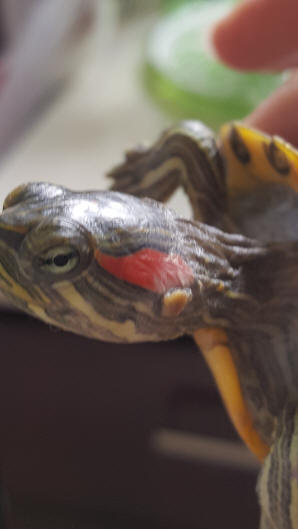 |
|
My red eye slider 5/6/15
Dear Crew,
<Hiya, Darrel here>
I'm not sure what this is. Or what to put on it? Help
<Sure. That right there appears to be a simple physical abrasion caused by
continual rubbing against something sharp. The treatment is to dry dock
her, treat with Betadine liquid and let her heal. Read here:>
<http://www.wetwebmedia.com/FWSubWebIndex/treating%20RES%20Dis%20DarrelB.htm
>
<Sometimes, when they get a bit obese, their skin will rub on their own shells
too much and this will result, but usually it's something else they come in
contact with. Search around her habitat and see what might be causing this>
Re: My red eye slider 5/6/15
Thank you so much for your help!
|
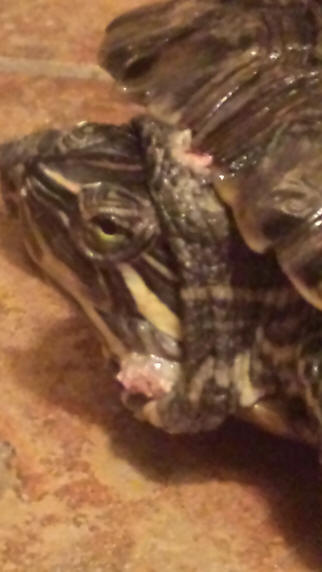 |
RES turtle help please; trauma
11/21/14
I was feeding my RES and when I turned around he somehow climbed out of
his feeding bowl and fell 4 feet down on my hardwood floor!
I picked him up and he was hiding in his shell but now he won't come out
so I'm worried bc I can't check on him. Will he be okay?
Leah
<More than likely he'll be fine. Turtles have evolved to be (a)
physically resistant to damage and (b) smart enough to stay in their
shells when something traumatic happens. In the wild and in the absence
of humans this combination has stood them in good stead for some 200
million years! So, assuming the shell isn't cracked and there's no sign
of bleeding, best thing is to leave your turtle alone in his vivarium,
with a nice dry spot under his heat/UV-B lamp(s), and see what happens.
He my take some time to regain his confidence, but he should do in time.
But if you're in doubt, contact your local vet or animal welfare
charity. X-rays can be done on turtles and will reveal any damage.
Cheers, Neale.>
Limp turtle 5/24/14
Hi there,
<Hiya Lecia - Darrel here>
I have had my red ear slider for four months and he has been doing great
until two days ago when I bought female slider. The next day he seemed
to have some kind of attack, he jumped into the water and went
mad for about a minute and then limp again, floating on his side.
<That is never a good thing>
This continued a few times and now he is just completely limp. His eyes
are half open but there seems to be no movement at all. Unfortunately I
can't get him to a vet as there are none that treat turtles in my area
<There is very little a vet could do for him anyway, Lecia>
<From your description it's hard to imagine what may have gone on -
unless the female was much bigger and somehow bit him or crushed him in
a way that caused internal injuries... then his condition is hard to
explain>
<The TREATMENT is not hard. Take him out of the water, place him
somewhere warm and dry. If he's even barely alive this may give him an
opportunity to stabilize and improve... but if his eyes remain half open
for more than an hour it's likely that he has passed on.>
Re: Limp turtle
Thank you for your reply. I am rather confused myself by what happened
as the female is younger than him and up until yesterday he showed no
signs of being ill. I did try take him out and keep him warm but
unfortunately he passed away
<On behalf of Bob, Neale, Sue and everyone on the crew, we're sorry for
your loss, Lecia.>
Limp turtle... Damaged RES 4/26/14
Hi there,
<Hia Lecia - Darrel here>
I have had my red ear slider for four months and he has been doing great
until two days ago when I bought female slider. The next day he seemed
to have some kind of attack, he jumped into the water and went mad for
about a minute and then limp again, floating on his side.
<That is never a good thing>
This continued a few times and now he is just completely limp. His eyes
are half open but there seems to be no movement at all. Unfortunately I
can't get him to a vet as there are none that treat turtles in my area
<There is very little a vet could do for him anyway, Lecia>
<From your description it's hard to imagine what may have gone on -
unless the female was much bigger and somehow bit him or crushed him in
a way that caused internal injuries... then his condition is hard to
explain>
<The TREATMENT is not hard. Take him out of the water, place him
somewhere warm and dry. If he's even barely alive this may give him an
opportunity to stabilize and improve... but if his eyes remain half open
for more than an hour it's likely that he has passed on.>
Re: r.e.s turtle indoor enclosure
3/21/14
Hello
<Hiya - Darrel here>
my RES back small toenails are bleeding
what should I do?
<Take her out of the water and let her dry off. If the bleeding doesn't
stop, pack it off with anything absorbent - even a paper towel - for a
few hours until it does. You might have to be
creative in keeping her immobile while this happens. Then coat the
wounded area with a disinfectant such as Betadine (iodine) or even
hydrogen peroxide and let than dry.>
<the BIG concern is what caused the bleeding and making sure you find
and correct that. Read here for everything you need to know:
http://www.wetwebmedia.com/FWSubWebIndex/treating%20RES%20Dis%20DarrelB.htm
|
RES can't stay out of trouble... 7/15/13
Hello WWM Crew!
<Hiya Darrell - Darrel here>
You've been so helpful before I thought I'd ask you about this. A
while ago I told you about my Red Eared Slider that climbed up and fell 4 ft
out of her tank, cracking her shell. I took her to the vet, we got
her fixed up, and life was good! Now, we have another problem. Apparently
she didn't learn the first time that trying to / succeeding in climbing out
was a bad idea. She started trying to climb out again, but since I had
secured the grille/mesh top much more securely, she couldn't succeed.
Instead, she climbed and clawed and I could see her pretending she was
Spiderman with her claws up in the holes of the grille. She eventually
stopped, but I think I figured out why...I think she injured herself
doing it.
<That does sometimes happen, unfortunately>
I found open sores on her hind and fore legs (hind left is the worst) and on
the bottom of her neck. After some observation, it seems the most likely to
me that these began as cuts - all the sores are in spots that come in direct
contact with a (relatively) pointy part of her shell. I have since cleaned
the tank again and applied Neosporin to the sores - she is currently
dry-docked and still trying to climb out.
<This time of year she may be trying to nest>
Another injury I noticed is her front left leg/claw. I think it might be
sprained or broken. She usually claws with both legs trying to "get out" of
the tank, but instead, she's using her...well...for lack of a better term,
elbow, instead of her claw to hold herself up on that side. I've attached
pictures. When I was holding her to get at the sores I extended that leg and
it didn't feel broken (then again, I'm not a vet) and she seemed able to
push at me with it. I can see a little red around the base of all her fore
claws, which reinforces for me that this came from climbing/clawing the
grate over the basking area.
<Looking at the pictures, I would also guess that it was broken.>
My question is...should she be OK in a freshly cleaned tank after being
dry-docked a bit with Neosporin on the sores/wounds?
<A "bit" should be a minimum of a week - better would be three weeks.
Neosporin and Betadine on any open cuts at least once a day>
Should I add an antibiotic to the tank?
<No - that would be a waste of money>
If so, what's a good one?
<there isn't a good antibiotic for putting in water. Even for fish,
this is a highly problematic method of treatment>
Also, does her left fore claw seem broken? How would I even tell? Vets are
expensive and while I do care about her, I also can't afford a hundred
dollar vet visit just for them to tell me she's fine, it'll heal on its own,
and there's nothing additional they can do.
<I completely understand. It DOES look broken (but it may NOT be
broken)
and even if it IS broken, the cost of setting it, splinting it and other
treatments becomes prohibitive.>
<Two suggestions. First, do some research in your area to find a
turtle and tortoise club. With a little investigation you may find a
very experienced keeper in your area that could give a 'hands on'
examination and maybe even help you treat her. Failing that - let her
heal on her own.
Turtles are amazingly adaptable animals. I had a large female that
had one of her front legs bitten off by a raccoon and the other bitten off
at the elbow. She not only continued to thrive, but she swam,
competed with the other turtles for food and even laid eggs. It
seems that if their internal organs are healthy their limbs can handle
extreme conditions>
Thanks for all your help!
-Darrell
<The bigger issue to me is to try to find out why she is so determined to
get out of whatever enclosure she's in. This time of year many females
get 'antsy' looking for some nesting material, but this seems beyond that.
Try something different, if you can. Set her up in a big cardboard box
(or 2 boxes taped together) or maybe put her in a dry bathtub for a few
days. If you have the time, let her take an hour on the lawn (CLOSELY
supervised, 100% of course) to see if she heads for open dirt and tries to
claw at the earth. I think if you get to the bottom of why she's
trying to escape, she and you will be happier>
|
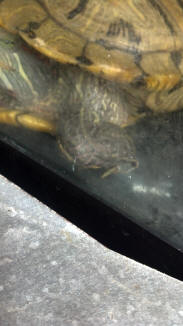
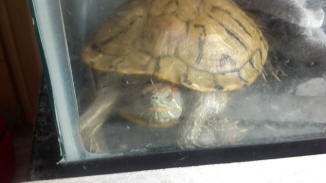
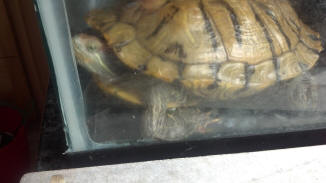 |
|
EMERGENCY, red-eared slider turtle Trauma injury
6/8/13
Please, I need urgent assistance with my baby red eared slider turtle.
It was stepped on by a small child while walking it in the grass. I
don't know how to treat it. It does not want to move besides cringing
when touched. The only visible change is the inflamed translucent layer
around its eyes. Please, I need to help it.
<Roney, I'm so sorry for your situation. The little guy has
suffered some internal damage - how much, we're not certain - but it's a
really unfortunate symptom that his closed eye lids (which are the
translucent film you mentioned) are filled with what looks like blood.>
<The only thing you can do is to keep him warm, dry and quiet for a few
days to see if he improves -- I've seen it happen …>
<With that said the outlook here is not good and if he doesn't show
signs of more activity in the next 48 hours, the kind thing to do would
be to take him to a local animal shelter and ask if they can euthanize
him. >
|
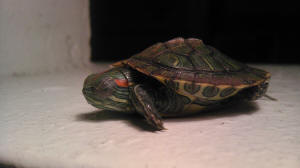
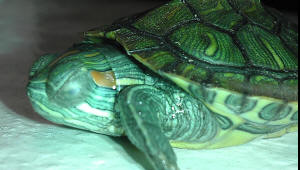 |
|
Please help my RES turtle! 9/2/12
Hello WWM,
<Hiya - Darrel here>
My name is Jean and I need advice of what to do for my RES Buddy
which recently got bitten by another Red Eared Slider that I
own, Mr. Turtle. I have read various articles about other turtles on
your site that have been through fungal infections in their feet/legs,
but I could not find one specifically about their toes.
<What seems to be the problem?>
I own 7 RES turtles and they never have had an issue like this before in
the past 2.5 years that I have owned them. Buddy and Mr. Turtle are the
same age, in fact, I bought them together when they were only the size
of a quarter. Their shells are about 3-4 inches long now, so they're not
that big. The other 5 I bought a year later and they get along fine with
Buddy and Mr. Turtle. They all live in a 25 gallon (I'm not sure of the
exact size because it was a gift from a friend) tank together.
<That's very small for 7 turtles. It's an invitation of unsanitary
conditions>
They don't have any of the equipment to keep the water warm or have any
heat lamps because I leave them outside of the house. Living in southern
California, it's quite warm and very sunny all day and slightly cool at
night. It never gets below 65 during summer/spring and is usually around
72-75 degrees at night. The turtles seem fine living outside.
<As long as they don't get attacked by dogs, cats or raccoons>
My mom and I have been raising them outside of the house for over a year
and it didn't cause any issues. When it's really cold during the fall
and winter I bring them inside so they stay warm and I put them in warm
water.
<Room temperature water is just fine>
I feed them ReptoMin turtle pellets and maybe once in a while leftover
chicken/duck from dinner (this isn't often, maybe every other month).
<No more than that - an occasional treat should be something like an
earthworm - but once every other month won't hurt them>
My mom cleans the tank almost everyday when the water gets really dirty
after they eat food. They often poop right after the tank gets cleaned
too ha-ha.
<In a tank that small, they should be fed separately: In something
like a Tupperware tub with 2 inches of water. Let them eat in
there and then poop a few minutes later and THEN back to their tank -
which needs to be bigger!>
The water is at about an inch and a half high because we only have small
rocks/shells where they can go sunbathe on.
<They need a much bigger enclosure. Maybe you can use a big
plastic tub from a building supply store>
Anyway, yesterday, I witnessed Mr. Turtle picking on Buddy's foot and
noticed that one of his nails were gone. I am not sure if he ate the toe
nail off or if Buddy already had an issue beforehand. I doubt that Mr.
Turtle just had a sudden appetite for other turtles because I feed them
every other day and he would have probably nibbled on the other 5
turtles by now, ha-ha.
<I agree>
Buddy was fine the day before yesterday so I do not believe that
anything happened before that. I took him out of the water about an hour
or so later because I Googled about foot infections for turtles. I then
immediately took him out of the water because every article stated that
you should take out the turtles from water ASAP and keep them dry to
prevent any fungal infections.
<Correct>
At first I let him have a little water and stayed in a small bucket by
himself. This morning I took out the water and let him stay under the
sun for most of the day so he can get as many vitamins from the sun as
he can.
Buddy still eats, but not as much as before. I find this a bit normal
because whenever I put him in another bucket he becomes afraid of eating
food for a while, then as he settles in, he eats a little.
<It's just the sudden change that scares him - don't worry>
After maybe an hour or two, I put him back in water for half an hour so
he has time to eat, poop, and drink. (I noticed he seems to be very
thirsty when I don't leave him in water like I usually do). Then I
repeat. I make sure he is dry when I take him out of the water. I should
also make it clear that I do put him in a bucket separate from the tank
because I am afraid Mr. Turtle might nibble on him again. He still moves
around like he normally does, but it really looks like he feels pain
when he tries to stand on his tippy toes because he always slides back
down to his right.
<He should stay dry for a few weeks to heal. Keep him warm and dry
and just put him in water (alone) each day to drink, eat and poop.
Read:
http://www.wetwebmedia.com/FWSubWebIndex/treating%20RES%20Dis%20DarrelB.htm
>
So, I've been doing all the things I mentioned all day today and I'm
wondering if I'm doing the right thing?
<Yes>
There are no vets around this area, well, I don't think I have ever seen
a vet office/building in my whole life... Even if I were to find one
around here, my Mom wouldn't allow it. She actually doesn't believe that
there's anything wrong with Buddy and I know for sure that she does not
want to pay for the vet fee (I hear it is quite expensive).
<Yes - and I don't blame her>
I don't know if we have any medicines that could help treat a turtle.
<Read the article above. Treat him with dry conditions and topical
betadine and he should be fine>
We mostly have moisture creams and cough medicine. That's about all we
have in our home, or at least that I know of.. I also send
some photos because I believe me describing his foot may be inaccurate.
I circled the abnormal toe just in case you can't really see it.
<Hope - you described it just fine>
In the attachments are photos of Buddy:
IMG_1661: how he normally looks (just in case you needed to know how he
looks) it's also him not in water
IMG_1660: back right foot (the foot that got bitten, top view)
IMG_1655: back right foot (bottom view)
IMG_1653: back left foot, which looks pretty normal, just in case you
needed to compare it
I'd really love it if anyone can help by giving any advice on what to do
and what to not do! Thank you so much for taking the time to read
my e-mail! I look forward to your reply!
- Jean
<Jean you are doing well. These turtles need more room, something
MUCH bigger - but that does not have to be expensive - think about all
the kinds of plastic tubs you can buy at the building supply or home
stores. Read
this:
http://www.wetwebmedia.com/FWSubWebIndex/RESCareBarton.htm >
|

 |
|
Turtle bruise? 3/11/12
Hi!
<Hiya - Darrel here. There was, apparently, an
'L' shortage when I was born, because my parents could
only afford one.>
So my Red Eared Slider that took a fall is doing
nicely!
<It's AMAZING what they can survive.
I have a female that lost both front legs to a raccoon and still
manages to live with and thrive alongside the others. Just
amazing. Glad she's all right>
She's healing, got a healthy appetite, and is still very
feisty! I noticed, though, that it looks like she has a purplish
bruise on her head. I've included pictures.
<Those are GREAT pictures, by the way. Just RIGHT in
terms of size, focus and content. I wish we could
document what you did so we can tell everyone how to do
that!>
I'm wondering if you can tell me what might have caused this
and if it's something I should be concerned about.
<Darrell - that's a tattoo. What we don't know
is if this was a break-up tattoo, a teenaged rebellion tattoo or
maybe she has signed on and is rolling with other, tougher
turtles. All you can do is keep up the love, hope she gets
over it and hope that you don't come home one day and find
the gang using her tank as a safe house.>
<Seriously … yes, that's a bruise and it's made more
pronounced because she rubs that particular part of her head
against the underside of her shell each time she retracts.
I'd dribble a few drops of Iodine on it and let it dry for 5
minutes twice a week for a couple weeks and not otherwise worry
about it.>
Thanks!
-Darrell
<Yer welcome - Darrel>
|
|
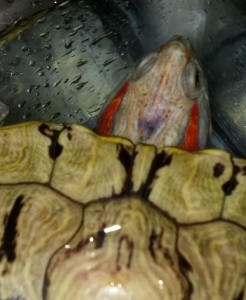
|
|
Red Eared Slider question, abnormal
foot 1/5/12
Dear WWM crew,
<Hiya - Darrel here>
I've been scanning through your turtle FAQ, couldn't find
anything similar though. In recent years my 9 year old Red Eared
Slider's been weak, not eating so much and lost weight.
<As they mature they will have less of an appetite - to match
they're slower growth rate. LOSING weight is unusual,
unless they were chubby as juveniles, then it does happen>
When I took her to the vet before they couldn't diagnose any
concrete disease but that her blood is abnormally thin (as if she
had been hit by a car or dropped from very high place and lost a
lot of blood, which hasn't happened) which would explain her
lack of strength, but they said they couldn't do much about
it and that she might pass on soon.
<that seems strange to me. Animals that lose blood and
don't die as a result then replenish that blood.>
However she's still been alive and kicking since then, still
weaker then before but maintained an even energy level.
<They are very resilient animals>
Why I'm writing to you know is because the other day I
noticed that her rear feet doesn't look as they usually
do. She has had a history of being bitten there by her
fellow turtles in the tank so she did have some scar originally
but now it looks like in the attached picture on both
"heel's".
<It's an interesting picture>
It's as if her skin has been pulled back in the heel and then
formed some kind of crater?
<Looks like skin forming around scar tissue from way over
here.>
It's a bit hard poking there and when I do, she pulls her
legs back in, I'm not sure cause it hurts or just because
she's always been a little careful. Any idea on what it
could be?
<Really hard to say from on-line, Sofia. This sort of
thing requires a physical diagnosis, but I sure wouldn't go
back the veterinarian that diagnosed "thin
blood">
<I think you should look online in your local area for a
Turtle and Tortoise Club or Society. If you can find one,
I'm sure you can find a local person who is an 'old
hand' at home diagnosis and treatment. Beyond
that, read here -- you COULD treat the heels as if they were
physical injuries dry-dock her, treat with topical antibiotics
for a week, etc.
http://www.wetwebmedia.com/FWSubWebIndex/treating%20RES%20Dis%20DarrelB.htm
>
Thanks a lot!
<Yer welcome!>
Sincerely,
Sofia
|
|
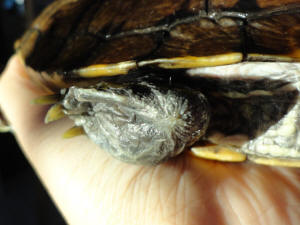
|
Red ear slider, trauma
12/22/10
Dear crew,
<Hiya - Darrel here>
My 2.5 year old female red ear slider recently fell from a height of 1
meter tall, twice..
<Ouch!>
once landing on her belly and another time, she landed on her back. The
second time she landed, she actually stayed still with her hands and
leg flared out for a few minutes
<I would too if that happened to me!>
( I was too shocked to touch her as I thought she actually died ).
After awhile she started moving.
<Good>
Every time I cleaned her tank, I would put her in my kitchen sink. I
think she must have grown a lot to the point she could actually climbed
out of the sink and that is when she fell off.
<The first time was an accident - you didnt know how well she could
climb. The SECOND time was negligence. Please don't let it happen
again>
My worry is that she might have internal bleeding. What should I do
now? She is moving around now, but in a very scared manner.
<You'd be scared too if I let you drop from 15 times your
height. And you might be a little cross with me, too.>
<Internal bleeding is an interesting question, Suyi. In the first
place there really isn't a practical way to tell since it's
unlikely we're going to x-ray her and even if we did it's an
inconclusive test. Second, even if there WAS, there's little to be
done. Surgery on Turtles and Tortoises is delicate and extremely
expensive.>
Thank you,
Suyi
<FORTUNATELY for all of us, turtles are tough little critters and
even cracks in their shells often heal and leave them no worse for
wear. I have a Red Eared Slider in my pond that lost BOTH front feet to
a raccoon and she still swims and carries on and fights for food and
space just like the rest of them>
<Suyi - be on the lookout of for signs of distress. Not eating,
closed puffy eyes, etc. If you encounter them, write back. Meanwhile
just try to give her a quiet and stress-free time until she's her
old self again. Meanwhile, when cleaning the tank, put her in the
bathtub -- or even a cardboard box that has sides high enough to
prevent her from climbing>
RES fell from balcony!! bleeding from mouth
HELP!! 5/5/10
Hi, I don't know why I didn't think to email you before but the
day before yesterday, one of my sliders managed to climb up what I
thought was an impossible height and fell 4 stories from my balcony, we
found him almost unscratched but bleeding a little from the mouth.
<Actually, damage to the head is very common when small animals fall
long distances. The force of impact is proportional to the weight of
the animal, so small animals hit the ground with relatively little
force. This is why he's survived a fall that would kill a human.
But the neck muscles are relatively weak, so the head of small animals
that fall long distances tends to hit the ground disproportionally
hard. Vets will tell you that when cats fall from high places, they
almost always have head injuries and broken teeth precisely because of
this: they can land on their paws fine enough, but the neck muscles are
too weak to brace the head properly, so while the limbs prevent injury
to the body, the neck can't do the same thing for the head. In
other words, it's very likely your turtle has a fractured jaw or
similar.>
He seems to be able to stretch and move legs/neck well but due to the
blood (obviously an internal injury) I put him in a separate tank with
about 2cm of warm salty water.
<OK.>
we have tried to contact a vet but it is 'golden week' a three
day long holiday in Japan and all the reptile vets are closed!
<Crisis! He really, REALLY does need to see a vet. It's entirely
possible he could survive this fall. After all, turtles and tortoises
have been accidentally dropped by predatory birds for millions of
years, and many of those turtles and tortoises walked away none the
worse for it. Their shells do provide considerable protection. But for
all that, if there are minor internal injuries, these will need to be
checked, and antibiotics given to ensure no secondary infections. Kept
warm and damp he may be okay for a day or two, but you do need to take
him to the vet as soon as possible.>
I thought he had recovered well and returned him to the main tank alone
today but after a short time of happily swimming about he climbed out
of the water and yawned without opening his mouth and now the bleeding
(although only a tiny amount) has started again, after finding
something similar on a forum I have now put him in a dry box with the
lamps. I haven't tried to feed him yet.
<Indeed. I'd keep him out of water for now precisely because of
the bleeding, and warm water would only promote the growth of
opportunistic bacteria. Don't let him dry out completely though,
and make sure he has drinking water. Spray him with a little water now
and again, just to keep his skin from becoming completely dry.
There's no need to actually make him wet. Take care not to
manipulate him though -- moving his jaws to force-feed him for example
could be very dangerous.>
Please offer any advice for me to help him or to make him comfortable
until we can contact a vet.
<Beyond keeping him warm and dry, there's not much you can do.
Iodine or salty water might be dabbed on any external injuries, but
again, you'll do more harm than good if you manipulate the turtle
too much.>
Regards,
Dale
Tokyo
<I've cc'ed this to "Turtle MD" Darrel Barton, who
may have some corrections to add. But for now, good luck! Cheers,
Neale.>
Re: re: RES fell from balcony!! bleeding from mouth
HELP!!
Thanks for the reply.
<Sorry it wasn't sooner.>
He's been in the dry box all day and has appeared to take a turn
for the worse tonight, I've put him in a couple of cm of very clean
water to give him a drink.
<OK.>
But wondering if he should be dry or wet overnight.
<Dry, in the sense of not being in water. But not bone dry; if the
air is dry, a gentle spray or splash of water will help.>
I'm honestly so worried about him.
<I can well imagine.>
My girlfriend will take him to a vet tomorrow.
<Good.>
He is still yawning without opening his mouth, he looks in pain.
<May well be.>
How often will he need to drink?
<He'll drink if he needs too; there's little you can do to
force him to drink.>
Thanks so much for the advice.
<Good luck, Neale.>
Re: RES fell from balcony!! bleeding from mouth
HELP!!
thanks again so much for the replies, I never would have thought he
could climb so high!
<Oh gosh yes, they can climb very well.>
I bought a spray bottle and I'm spraying him every now and then
(although he doesn't seem to like it) I have but him in a box lined
with a damp towel to keep him damp overnight, thankfully it is quite
humid and warm tonight so he shouldn't dry out too much.
<Very good.>
we are going to call the vet first thing and try to get an
appointment.
<Excellent.>
If this is posted on the site I beg any turtle owners reading this :
DONT UNDERESTIMATE THE CLIMBING ABILITY OF YOUR TURTLE!! he is only
about 4 inches long but managed somehow to climb almost 10" of
vertical smooth wall and then fall 4 stories!!
<Yikes! A timely reminder. Thanks for stating this so
clearly.>
Thanks again.
Dale
Tokyo
<Good luck to you! Cheers, Neale.>
Re: RES fell from balcony!! bleeding from mouth HELP!!
Hi,
Just an update on pecka one of my sliders who fell from the 4th floor
balcony of my apartment.
<Indeed.>
Thanks for the advice you gave it was really helpful but unfortunately
we could not get an appointment at the reptile clinic until late
afternoon due to it being closed all golden week and at about 1300 he
gave up and passed away,
<Too bad. I'm sorry to hear this.>
we are very sad to have lost a member of our household so I'd just
like to reiterate to everyone DOUBLE CHECK AND TRIPLE CHECK ANY AREAS
YOUR TURTLE (or any pet for that matter) CAN CLIMB.
<Indeed so.>
He climbed up a flat smooth wall more than double his outstretched
length.
He will be dearly missed, but we will take it as a lesson in taking
care of our remaining 2 turtles midori and LB (lazy boy).
<Quite so.>
Thanks again Neale for your help.
<Sorry about how things turned out.>
Dale
Tokyo
<Neale, Hertfordshire.>
Help with turtles my daughter brought home from school for
Christmas, RES comp. 01/03/10
<Hi Darrel here>
I am hoping you can help. My daughter brought home 3 turtles from
school for Christmas break. Using your website I have determined they
are red eared sliders, one male, one female and one baby. I think they
were mating yesterday. The male turtle attacked the baby and bit its
tail.
<Bad news. Adult turtles can be aggressive and kill baby
turtles>
The tail was bleeding and "stuff" was hanging out. We
separated them.
<Good too bad it didnt happen earlier>
Today the "stuff" on the tail is black, he won't eat and
he just suns himself under the light. Being the holiday, I don't
know what to do. Any suggestions?
<Yes. The first suggestion is, obviously, veterinary attention. Most
areas have an Emergency Pet Clinic thats open when the regular
Veterinarians are closed. Unfortunately, they tend to be expensive.
What the baby needs is a tiny bit of surgery and some
antibiotics.>
<Home treatment is a poor second choice, but for many of us it is
sometimes our only option: 1) Keep him warm and dry. No water at all
except a few minutes a day in a shallow bowl of lukewarm tap water in
order to bathe and perhaps eat. 2) Dip the black area (which is, sadly,
dead or dying tissue) in iodine or even hydrogen peroxide in an effort
to keep an infection from starting or spreading. There is a section in
this article regarding Cuts, Bruises and Bites that describes the
treatment in detail.
http://www.wetwebmedia.com/FWSubWebIndex/treating%20RES%20Dis%20DarrelB.htm>
<Turtles have remarkable abilities to heal and to live complete
lives even after substantial damage, but the bad news is that if the
bite has damaged or killed important tissue of his internal organs,
then this treatment may not be enough. Best of luck to you>
|
Turtle Shell: Injury or Fungus? 7/31/09
I've attached two photos of my six-year-old yellow-bellied
slider, Moose. His "twin" brother, Merytle Louis
Rutherford, has always been the bigger, stronger, more
coordinated, healthier, and luckier of the two, but we love them
both all the same. Moose has always had a much bumpier shell,
longer front claws, and slower overall growth since I got them
both as babies due to some metabolism issues which I try to
correct by separating the turtles regularly and giving Moose a
more calcium-rich diet and his own private basking spot.
<Smaller size and longer claws is also characteristic of
males, Adrian.
Maybe you have one of each sex.>
In spite of his handicaps, Moose recently managed to climb out of
his enclosure (now being completely overhauled with a much lower
water level and LOCKING screen cover in light of his new-found
skill),
<Turtles are AMAZING climbers. I've seen a 8 inch River
Cooter (a cousin to the Slider family) climb a 6 foot chain link
fence. Without a locking top, you have to have an inward lip at
least 1 1/2 times the length of the largest turtle.>
... ending up on his back, where I found him quite cranky and
stressed out a few hours later. At that time, it looked as though
he had just barely scraped the prominent points on his shell from
all the rocking back and forth in an effort to get himself
upright after the fall.
<When I encounter a turtle that's been upside down, I
always pick it up and hold it upright (Head UP/Tail to the
ground) for a few minutes to let the internal organs hang
vertically. Although uncommon, the stress of being upside down
and flailing as they do can cause the intestines to twist.
Again, not a very common thing, but a very easy & quick thing
to do>
Since then (it's been about a month), these supposed scrapes
have turned into something else entirely. When they didn't go
away initially, I started dry-docking him and disinfecting his
shell with peroxide, then iodine solution, then, finally, my
Nolvasan solution arrived from the vet supply store, and I
started swabbing the spots with that. Fearing shell rot in the
injured areas, I started trying to scrape the areas with a
plastic card, and treating with more antiseptic. The current
white areas, which have grown considerably, LOOK like exposed
bone in texture (though I know the entire shell is integrated
with the skeleton), and they are the result of the
scraping...what came off was just a thin layer of pigmented
shell, not even the thickness of Moose's normally-shed
scutes. After that horrific experience, I stopped trying to
scrape stuff off, and have just been using a soft-bristled
toothbrush to scrub the areas. The areas are not, and never have
been oozy or sticky or smelly.
<I don't think you've caused as much damage as you
think, Adrian. It's not possible to scrape off a healthy
scute with a plastic card. Something was already going on there
and all you've done has been to expose that condition (to
make a pun).>
Have I damaged my turtle unnecessarily in my vigor to treat an
imaginary case of shell rot? The exposed areas had started to
faintly show some of the pattern of the rest of his shell (which
is pretty pronounced for an adult), as if the cells were starting
to regrow, but that recently seems to have faded away, too,
leaving these huge blank white areas.
<The pictures show the bone that is normally under the scutes,
so the most obvious answer is that due to some cause not
currently known, but possibly related to something metabolic, the
scutes have died. This in itself is not fatal or even
debilitating. Moose can live a happy live of joy fulfillment as
long as we can find and correct the root cause. That and making
sure he doesn't become an Amway rep.>
<That said, finding the cause isn't as easy as it sounds.
If we assume you've provided proper diet, heat and UV for
both turtles then finding the source will likely involve a
scraping culture and/or a blood test.>
Now, since they're in temporary housing anyway as the new
tank comes together, I have them separated and Moose is, sadly,
back in dry-dock state with a bath every 24 hours, and halting
all the doctoring I've been playing at. What is the next
step, and what should his shell look like when, or if, it is
healing?
<Review every detail of your care instructions against the
care sheet below, Adrian. The best possible outcome here is that
upon detailed review, you find something subtle that might end up
making a huge difference. I'm not suggesting it's a Good
Thing(tm) that we find a mistake ... but if, for example,
you'd accidentally hung a plant-Gro bulb instead of a proper
UV bulb, the FIX would be easy and inexpensive. I want to cover
the basics 2 or 3 times before we have to resort to the more
esoteric and expensive.>
I am very concerned about Moose, as I am far too young and
irresponsible to have a REAL child, and I was really looking
forward to these little turts growing up to support me and place
me in a good nursing home in thirty or forty years...
<Well, you seem more responsible than a number of parents I
know, Adrian.
Besides, it's unlikely that turtles would be able to support
you in your old age ... they're financially irresponsible
(never let a turtle NEAR your ATM card)>
Thanks,
-Adrian
< http://www.wetwebmedia.com/FWSubWebIndex/RESCareBarton.htm>
<
http://www.wetwebmedia.com/FWSubWebIndex/treating%20RES%20Dis%20DarrelB.htm>
|
 |
Red Eared Slider missing two claws 7/26/2009
Dear Crew,
<Hiya -- Darrel here>
Hope all is well.
<Yes, thank you for asking>
For the last year, my husband and I have been caring for a Red Eared
Slider which we inherited from my in-laws.
<You're in-laws left you a turtle? I want to inherit some
property from my in-laws. Did they not approve of you or
something?>
Precious is an approximately 15-year old female turtle and is fairly
large.
Her home is an medium-sized outdoor pool, bigger than the
"kiddie" size with an inflatable ring around the top.
Recently, around a month ago, my husband rescued a smaller male RES
from a busy street after witnessing it get struck by a car. He did not
seem to be too severely injured, but a couple of the scutes at the back
of his carapace were damaged. We decided to let him
<let's call him Ted>
recuperate with Precious, and they seemed to be getting along okay,
though they do compete over food. We were considering releasing him
back into the wild, but he acclimated to us so quickly that we thought
he must have been a pet at some point and was dumped some time ago.
Also, we are aware that Red Eared Sliders are not native to Florida and
are considered an invasive species. So, we were going to keep him
<Good. We never, ever, EVER release animals into the wild! EVER. The
Red Eared Slider may not technically be native to anywhere the
northwest most corner of Florida, but for all practical purposes the
horses have already left that barn. But even so, there are communicable
diseases to consider -- turtles have them and the easily spread them to
other colonies. Not only that but a captive-raised turtle, even if it
was originally wild caught, is at a huge disadvantage in everything
from natural immunities to microbe loads to natural fear responses. So
thanks for never doing that.>
Today as I observed the two turtles competing for a spot to get food, I
saw that 2 of his claws on his right front foot are just completely
missing. I am worried that he may have been bitten my the much larger
female, though he does not seem horribly intimidated by her (though he
does get the heck out of her way when she's on the move).
<That would be very unusual but I've always wondered about that.
Here he comes with these long fingernails, waving them in her face all
the time, as if to say "Look!!! I have long fingernails aren't
they beautiful??"
meanwhile she's swimming there FUMING to herself .. thinking
"I've been trying to grow nails like that for FIFTEEN YEARS
and every time they get longer than a quarter inch some darned thing
comes along and breaks or chips them ... and then HE falls in here
showing off like that ....I ought to bite those nails right off of him
.. and maybe a few other things, too!">
He is about a third the size of her.
<Males are much smaller>
Also, there is no wounding apparent on the surrounding flesh of the
area.
I haven't read about this in other resources and am concerned. My
husband was laid off recently, so a vet is not an option. How should I
treat this and is it likely caused by aggressive behavior?
<A thorough examination of the area and the whole turtle is in
order. If there is no damage visible, things look like they're
healing or healed, the rest of the skin is clear and colorful, the
shell is hard? Is Ted active and eating well? Do they bask
together?>
<If the answers to all these are "yes", then just keep a
weather eye out for a future infection at the base of the nails and
otherwise just assume that it adds character.>
Thank you for all your time and the great advice I've found on your
website.
<We thrive on compliments! Keep 'em coming!>
Melissa
|
Injured Turtle Arm 5/12/08 Hello Crew,
<Hiya Justin, Darrel here> I have a small yellow bellied
slider (around 2.5 inches) that recently got its front right limb
bitten by a larger (6 inch) red eared slider. <ouch!> The
arm is still intact and seems to not have been fractured in any
way. However, it is now somewhat brown in color, and the smaller
turtle swims around with it tucked to its side, only swimming
with both arms occasionally. <You would too if someone bit
your arm. That he uses it sometimes is a good sign> I already
separated the smaller turtle to its previous tank (10 gallons).
He/She now lives in the tank with two gold fish (originally meant
to be fed, but ended up becoming... "companions").
<That happens all the time, I have some "feeder"
goldfish that have almost become Koi> First, I realize I
probably need to disinfect the wound, but I don't know how,
and with what. Second, after disinfecting, I need to let it scab
over, but what if the wound has already scabbed over? or you
can't tell because its kinda.. soggy looking and brown.
<First, lets take the turtle from the water and keep him dry
for a week. Nothing overly complex, even a cardboard box with
high enough sides is OK. We want the wound to be DRY and stay dry
until healed. Do this right away.> <Once dry, get some
iodine solution (Betadine or something like that from a local
drug store should be very cheap) and pour some on the leg each
day for about a week> <It will be hard for him to move
around because turtles don't "limp" very well, but
using the leg is great and keeping it dry is critical> Third,
is there anything I need to add to the water to keep it cleaner?
and how often should I change the water? <I'll give you a
link with simple care instructions, but basically filtration is
needed to keep the water clean and you should change the water
frequently enough that it looks and "smells" clean.>
Also, will the two gold fish, shrimp, or crickets that are fed,
contaminate the water? <Umm, well, once he's healed, the
goldfish are now part of the 'family' and you
shouldn't be feeding crickets or shrimp anyway. Small Koi
pellets (read the article in the link) is the best quality food
you can give the turtle and the goldfish will thrive on it,
too.> Thank you very much! <yer welcome!
Re: Injured Turtle Arm 5/13/08 How do I give him food and
water while keeping him out of the water? <
<While it's true that turtles eat in water (or at least
eat BEST in water) food isn't our # 1 concern. We're
worried about infection and water and moisture are what we need
to fight here.> And now that I look a little closer, the back
leg is also bitten, but this one is just a cut, the front leg
however now looks swollen and I can't tell if this...
equivalent of the wrist area is broken. The front limb is so
swollen (or broken) that it's always bent downward, but he
still uses it and walks on it when I take him out of the water.
<And walking around on it is probably painful for him as well.
Given more time and resources you could keep in something small
enough that his activities are limited -- no ability to use the
arm means he rests it. But mainly I WANT THAT ARM DRY AND COATED
IN DISINFECTANT RIGHT AWAY. If he's other wise healthy he can
go a long time without food and water ... plus after a few days
of being very dry and disinfected, you can put him in a small
dish of water for about 5 minutes every other day and offer him
some food at that time. But right now, get it dry, keep it dry
and disinfect it. After about two weeks you'll have an idea
how well it's healing and whether or not he's ready to
get wet again.> Thanks again. Justin <No problem!
Regards/Darrel>
Re: Injured Turtle Arm
5/19/08 Hello Crew, <Hiya Justin, Darrel again> He
looks like he can bend his wrist area again, hopefully meaning
its not broken. <good> Is it better to leave him in a small
container that he tries to climb out of (to limit his space..
will he just give up and stop moving)? or just leave him in the..
1ft by 2/3ft tub he's in that he's in? he sometimes walks
on it.. and tries to crawl out still... it has a heating lamp and
a shaded area. <that sounds fine. Dry plus the ability to
regulate temperature is fine> When do I know I can put him in
water to eat/drink? and should I keep him out of the tank until
he's completely healed? <5 minutes at a time, 3 times a
week - shallow pan, just so he can drink. Wait a 3-5 weeks until
the skin looks WELL healed before putting back in his habitat>
Also, his tail is shorter... the thinnest part of it is gone
seemingly.. will this have much of an effect on his life (just
noticed...)? <Not at all, Justin. Turtles are very resilient
given half a chance!> Thanks again! He seems to be getting
better. <Glad to hear it -- keep up the good
work!> Re: Injured Turtle Arm
5/23/08
<Hiya Justin -- Darrel here> So, I try to feed my turtle
when I give him his 'baths' now, but I don't know
what to feed him. He ate carrots, and I'm out of crickets and
meal worms (haven't fed him those since he was injured, but
he eats them), but I've always tried getting him to eat
either the Koi pellets or the Turtle Pellets, and he won't
eat either. Is there any approved or effective method of turning
turtles to pellet food? <Generally speaking -- if you have a
turtle that's otherwise healthy all you have to do is wait
and when he gets hungry ENOUGH ... he'll eat the pellets. In
this case he may not eat at all in the strange and different
surroundings and mainly what we want is hydration (drinking) --
much more important to him in the short term than nutrition>
Thanks again, his arm is making progress, but he doesn't ever
bend it at the wrist area, leading me to believe it may be broken
after all, the swollenness of the hand area hasn't entirely
disappeared yet either. His back legs are still cut, but
that's about it, they look like they'll heal over time.
I'm just worried about his front arm (and I guess his tail is
a hopeless cause?). <Nothing is ever hopeless, Justin. I have
a rescued Slider in my pond that lost his entire front leg to a
raccoon, Needless to say her 'walking' is strange and
comical -- more of a flopping around that really walking -- yet
she thrives enough to lay fertile eggs every year! Once the cuts
on the skin (front & rear) have healed over and you're
sure that you've got a handle on preventing infection, you
can place him in the main tank (away from the meanie that snapped
at him in the first place) for an hour or two -- you might find
that after a half hour or so his appetite returns. As long as he
gets dry after that and back to his healing routine, a few hours
in the water will be good for him. Darrel>
|
| Problem with RES and white stock above
head 5/8/08 Hello WWM, <Hiya,
Darrel here tonight> We have 3 red eye sliders, with the temp
been 78-82, feeding them ReptoMin, two filtering system and all
Reptisafe for the water treatment. I Also have uv light that I cant
not remember at this time the ratings on it. Now about the wound or
whatever. It started as a white spot and now today its showing what
appears to be reddish color and the skin is peeling... <The
water temp is a little high -- 65 to 78 would be fine -- let then
bask under a heat lamp to get any warmer. I'll include a link
at the bottom of the page. ReptoMin is a fine food, a good quality
Koi pellets are essentially the same food for a lot less money>
I've attached a link to my photobucket so you can see the
pictures. Hopefully be a better explanation for the turtle...can
you please inform me on what this might be perhaps?? <Good
pictures, Gino. Everything I see points to simple mechanical damage
-- that means rubbing or cutting on something, even on the top of
his carapace (top shell) as he climbs in or out of the water. It is
too localized and right near where the neck tends to rub on the
shell to be a systemic infection.> <Read below for my
recommendations? Thank you. Gino PS: Is it possible that rocks
might have gotten in its neck and cause it to get injured???(there
tank we put them into when clean has rocks in it) <Yes, somehow
this is an injury and we want to heal it before an infection sets
in. First, take him OUT of the water and keep him out until the
neck heals. You don't have to go to any great expense ... even
a cardboard box with high enough sides that he can't climb out
will be just fine. An animal is as generally good shape as this one
appears to be can be without water and/or UV for months if
necessary, so don't worry about that. (A) Take him out to some
place dry (B) After his skin is actually dry, dribble or drop some
Betadine or any kind of iodine solution on the neck (C) Every day,
place him in a shallow bowl of water for 5 minutes to hydrate and
eat -- he may NOT eat, don't worry about that yet -- and then
when he's back in his box and dry, repeat the Betadine. Keep
this up for a week or so and the skin should heal nicely.>
<In the mean time, observe his behavior for how & why he was
straining & rubbing his neck -- or look for the sharp rock or
corner in his permanent home. Once he's healed and you've
found & fixed the source of the abrasion, he can move home
again an get what otherwise looks like GREAT care from you.>
<Regards, Darrel P.S. read this: http://www.wetwebmedia.com/FWSubWebIndex/RESCareBarton.htm
> http://i8.photobucket.com/albums/a46/gEE805/IMAGE_203.jpg
http://i8.photobucket.com/albums/a46/gEE805/IMAGE_201.jpg
http://i8.photobucket.com/albums/a46/gEE805/IMAGE_199.jpg
http://i8.photobucket.com/albums/a46/gEE805/IMAGE_197.jpg
this picture shows how the neck looks from a profile shot http://i8.photobucket.com/albums/a46/gEE805/IMAGE_194.jpg
http://i8.photobucket.com/albums/a46/gEE805/IMAGE_191.jpg
http://i8.photobucket.com/albums/a46/gEE805/IMAGE_188.jpg |
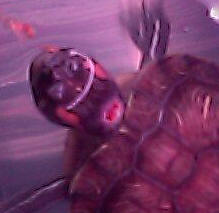 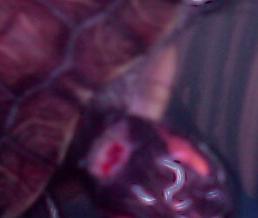 |
Female Turtle Biting Off Male Turtle's Nails
2/25/07 Hi! I have 2 RES who are 3.5 yrs old and have always lived
together happily. One is a male with .5 inch long nails and
considerably smaller then the other one. Recently I noticed
that the little guys was missing a nail and his hand looked a little
pink. Tonight I noticed another missing from the other hand
so I decided to take a good look at him. During his mating
dance the female took a snap at him and took off another
nail! My little guy doesn't seem to be in any pain and
there is no blood etc. My questions are: 1. Is
this normal? 2. Is there anything I should be doing to treat
the missing nail. Your help is much appreciated! < These are just a
few of the problems people have when they keep more than one turtle
together. The male wants to mate and his showing off to the female. In
nature she would just swim away. Unfortunately in an enclosed space
like an aquarium she has nowhere to go so she tries to discourage him
by biting at him. The nails may grow back. Keep the water clean so they
don't get infected. Add a Dr. Turtle Sulpha Block by ZooMed to
inhibit any bacterial grow.-Chuck>
RES With Wound On Foot 2/26/07 Thank you so much
Chuck. Is there anything in particular I should
do with the wound on the foot of the male
turtle? Obviously , I can't keep it
dry...lol. Thanks-Trish < Keep the water clean. Add a Dr. Turtle
Block to the water and give him a Repti Turtle Sulpha
Dip.-Chuck>
Turtle With Trauma To The Neck Area - 10/22/06
Hello! I have a red-eared slider who is about 11 years
old. The tank she is in is actually a horse
trough. I built a shelf that sits just below the water which
has about a dozen large rocks on it. Things have been fine
for years. Then about three weeks ago when the turtle
"Lurtle" was out for some sun, I noticed a large wound on her
neck. I emptied the tank and found a medium sized rock
at the bottom, and I believe this rock after falling off the shelf
caused the injury. The wound was not bloody, it almost
looked like a wet scab had formed. I have made sure to clean
the water every few days, but the wound actually seems to be getting
worse. And today, when I checked the scab, it was
raw. Where the sore is located, every time she extends her
neck it rubs against her shell. She seems to be acting fine,
still eating, swimming, basking, etc. Are there at home
remedies or should I go ahead and take her to the vet? Also,
do you have any suggestions about her tank to make sure this does not
happen again? Thanks, Kara < Sounds like the wound has gotten
infected. Keep the water as clean as possible. Use the Repti Turtle
Sulpha Dip by ZooMed and the Repti Wound Healing Aid. The Dr Turtle
Sulpha Blocks will inhibit bacterial growth and keep things from
getting worse. Use some PVC pipe to make a shelf so she can get out of
the water but also hide underneath it. Attach some wood to the PVC
shelf and she will be fine.-Chuck>
Turtle With Bump On The Neck 9/22/06 Hi, I
recently bought a tiny red eared slider turtle and he seems to be doing
fine. However, he has a strange bump on his neck that is
yellowish and barely raised. It almost looks like a growth
or fungus of some kind. What is this? Sara < Could be some trauma to
the neck that has gotten infected. Keep the tank clean by doing water
changes and clean the filter often. Add a Dr Turtle Sulpha Block to the
water to treat the infection. You may need to place some Repti Wound
Healing Aid directly on the spot.-Chuck>
Turtle With Mouth Problems 3/27/06 I have a
red-eared slider that is about 1 year old. It was eating
it's turtle dock and I picked it up to see if anything was in
it's mouth and I noticed that it's mouth does not completely
close. It closes in the middle and has gaps on both
sides. It only touches at the middle point. Is
this normal? I searched in my turtle book and did not find
anything. Thanks, Ami < In an effort to obtain minerals
not found in its diet, it has tried to eat some of the algae off the
turtle dock and has probably damaged its mouth. Change the diet to add
more greens like spinach and kale. Older turtles require more vegetable
matter than younger turtles. The damage may heal over
time.-Chuck>
|
|

